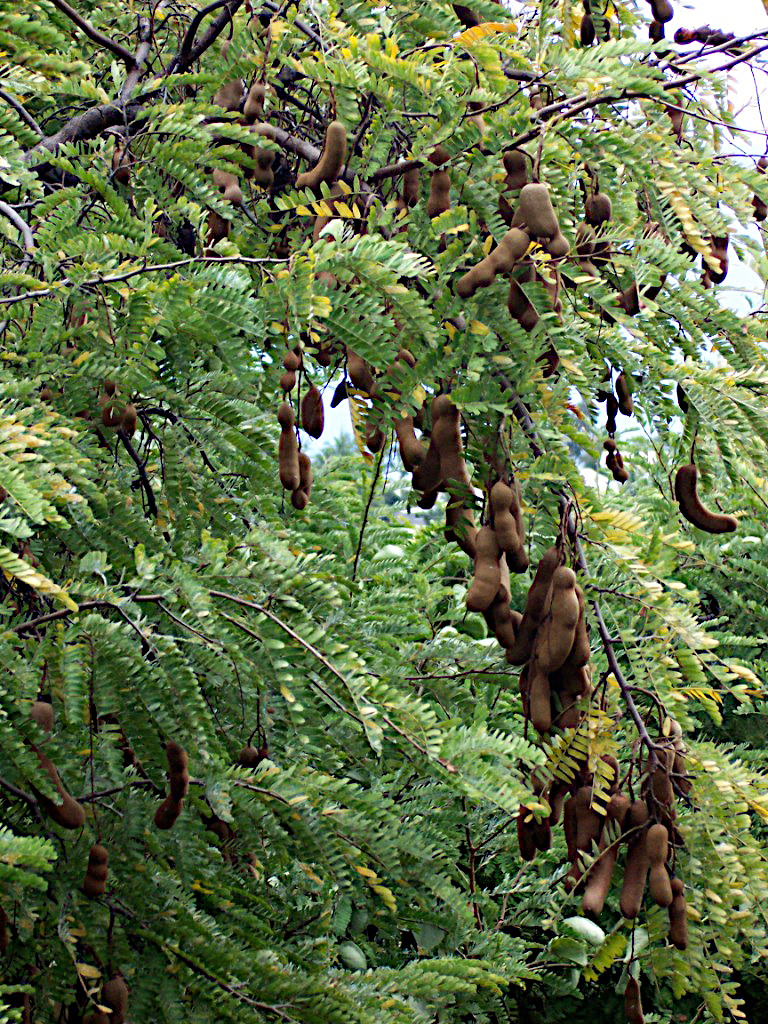Tamarindus indica L. - syn.Tamarindus officinalis Hook., Siliqua arabica Bauh. - Fabaceae
tamarind, Tamarinde
Evergreen tree, 12-25m high, native to tropical Africa, widely cultivated; leaves pinnate, leaflets 5-12.5cm long; flowers fragrant, with 3 white petals, turning yellow with pale red stripes, 3 stamens; pods brown, up to 20cm long and 3cm wide, with 3-12 shiny brown seeds; the mesocarp turned into a pulp.
„Tamarind is valued mostly for its fruit, especially the pulp, which is used for a wide variety of domestic and industrial purposes. The acidic pulp is used as a favorite ingredient in culinary preparations, such as curries, chutneys, sauces, ice cream, and sherbet in countries where the tree grows naturally. In India, the pulp is also eaten raw and sweetened with sugar. Tamarind pulp is also used to make sweet meats mixed with sugar called Tamarind balls. Tamarind pulp is used as a raw material for the manufacture of several industrial products, such as Tamarind Juice Concentrate, Tamarind Pulp Powder, tartaric acid, pectin, tartrates, and alcohol.“
http://www.ncbi.nlm.nih.gov/pmc/articles/PMC3210002/
„…the overall aroma of Tamarind consists of citrus notes and warm spice-like flavors with some roasted character.“ Important volatile compounds associated with tamarind were monoterpenes, which provide citrus notes, 2‐acetylfuran with a woody, resinous, cinnamon note, and furfurals with sweet brown notes similar to caramel.
[Lee, Peter L., Greg Swords, and G. L. K. Hunter. „Volatile constituents of tamarind (Tamarindus indica).“ Journal of Agricultural and Food Chemistry 23.6 (1975): 1195-1199]
„The volatile constituents of the fruit pulp of Tamarindus indica L. were isolated by steam distillation with subsequent extraction of the distillate with dichloromethane. The concentrated extract was analyzed by capillary GC and GC/MS. Sixty-six compounds were identified, furan derivatives and carboxylic acids were dominant, accounting for 44.4% and 33.3% of the total volatiles, respectively. The major components were furfural (38.2%), palmitic acid (14.8%), oleic acid (8.1%) and phenylacetaldehyde (7.5%).“
[Volatile Constituents of the Fruit of Tamarindus indica L., Wong, K.C., Tan, C.P., Chow, C.H., Chee, S.G., Journal of Essential Oil Research, Vol.10(2), 1998, 219-221]
„Volatile components of tamarind fruits grown in Cuba were isolated by simultaneous steam distillation/solvent extraction. The fruit pulp had approximately 3 mg/kg of total volatile compounds. Eighty-one constituents were identified, from which 2-phenylacetaldehyde, 2-furfural and hexadecanoic acid were the major compounds.“
[Pino, Jorge A., Rolando Marbot, and Carlos Vazquez. „Volatile components of tamarind (Tamarindus indica L.) grown in Cuba.“ Journal of Essential Oil Research 16.4 (2004): 318-320]
Among the phytochemicals detected in the acetonic, ethanolic and methanolic extracts of tamarind pulp by GC-MS, the compounds 2,3-butanediol, furfural, and 5-methyl furfural were dominating.
[Phytochemical detection and in vitro evaluation of tamarind fruit pulp for potential antimicrobial activity., Jadhav, D.Y., Sahoo, A.K., Ghosh, J.S., Ranveer, R.C., Mali, A.M., International Journal of Tropical Medicine, vol.5(3), 2010, 68-72] http://www.medwelljournals.com/fulltext/?doi=ijtmed.2010.68.72

Tamarind tree (Tamarindus indica) with pods (2005)
CC BY-SA 3.0, Author: B.navez Wikimedia Commons



